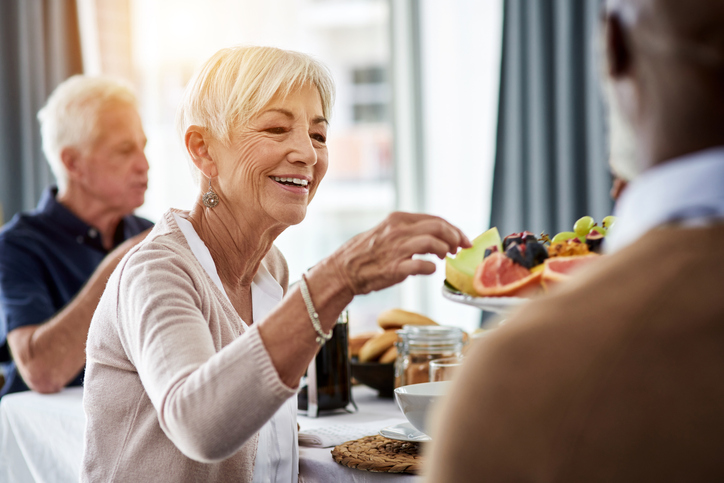We all want to live a longer, healthier life, and what we eat plays a big role in helping us achieve that. Like many of us, you may have noticed that what and how you eat has changed over time, but did you know that your nutritional needs have changed, too?
As we age, our bodies require different nutrients to maintain our health and well-being, and senses related to hunger and thirst may decline. With that in mind, what does a healthy diet for seniors look like, and how can you get the nutrition you need to live an optimal life?
Before making any dietary changes, be sure to speak to a medical professional or nutritionist about your particular needs.
Celebrate Variety
While it can be tempting to stick to the same handful of foods you love, eating a variety of foods is key to getting the nutrition you need. Focus on whole foods like fruits and vegetables and minimally processed grains. This includes green leafy vegetables, fish or chicken, and healthy fats like olive oil or avocados. The more that a food is processed, the less nutrient dense it is and the less fiber it contains (fiber can help with digestion, as many of us know!). For instance, a whole apple contains 95 calories, 0 gram fat, 1 gram protein, 25 grams carbohydrate, 19 grams natural sugar, and 3 grams fiber. However, when it’s even minimally processed into apple juice, it no longer contains any fiber, and the sugar content goes up, giving it more calories. Apple juice is also less likely to make you feel full, meaning you’ll drink more of it.
Choose Healthy Snacks
Healthy snacks provide us the nutrient-packed punch we need to stay active without packing an excess of calories. Reach for whole or minimally processed foods that are high in fiber and protein, which can help keep you feel full longer. Also be sure to watch your portion sizes. Caloric requirements change over time, making it easy to overeat. Even too much “healthy” food can be a bad thing! Moderation is key in all things.
Be Mindful of Hydration
When was the last time you drank a glass of water today? Getting enough water is essential to our overall health. In fact, our bodies are composed of roughly 60% water. Staying hydrated becomes more challenging as we age because our sense of thirst can diminish over time due to changes in our balance of water and sodium. Make it a habit to get at least eight glasses of water a day, and watch out for signs of dehydration like headache, dry mouth and fatigue.
Consider Dietary Needs
Finally, it’s important to talk to your doctor or a registered dietitian about any specific dietary needs you may have. Some older adults may need more vitamin D or calcium. Others may need to follow a heart-healthy or diabetic diet to help them manage specific conditions. Your doctor can help you determine the best diet for your individual needs and can provide guidance on any necessary supplements.
Live and Eat Well at Village on the Green
Village on the Green is a Life Care community in Orlando, Florida that caters to sophisticated and vibrant seniors seeking an unparalleled living experience. We have crafted a culture of wellness that is focused on individual goals and needs. In addition, residents take advantage of numerous opportunities to learn, play and grow in a connected community with resort-style amenities and services.
See for yourself what living at Village on the Green could look like for you. Learn more and schedule a tour here, or complete the form below.


